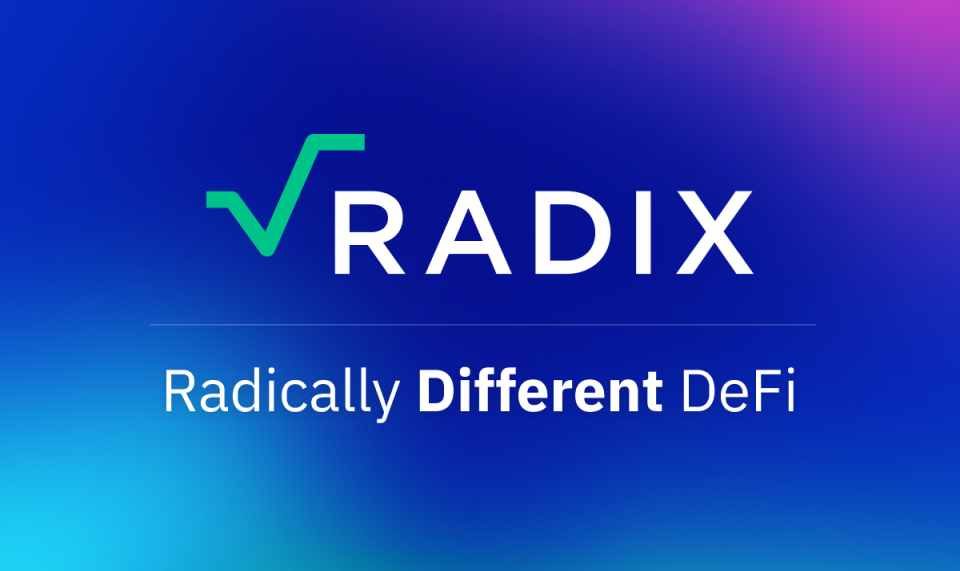Radix Unveils Its Vision Of “RadFi”, A Radically Different Approach To DeFi That’s Scalable & Easy To Use

The existing crypto experience is “absolute garbage”, according to Radix CEO Piers Ridyard, and unless the DeFi industry undergoes a radical transformation, it doesn’t have hope in hell of replacing the traditional financial system that it rivals.
Ridyard was delivering a keynote speech introducing the concept of “RadFi”, an entirely new and radical infrastructure overhaul for DeFi that has been almost 10 years in the making, and he made no bones about the problems facing users, developers, and entrepreneurs in the industry today.
Until those problems are fixed, he said, there is not even the slightest chance that the average guy in the street is going to adopt DeFi as an alternative to their traditional bank account and credit card.
“Will mainstream users ever be okay with a MetaMask popup that basically says sign this hash, hope for the best”? he asked. “Not a chance. Will your mom, your uncle, or your cousin ever be able to remember to write down a seed phrase, break it into three parts and securely store it in three locations? Not a chance.”
In order for DeFi to be able to rival existing financial systems, Ridyard said the average person is going to need an experience that’s as safe and as intuitive to use as the kinds of Web2 apps we rely on today. It’s not just users though, for the CEO said developers equally need tools that allow them to encode their ideas more easily, and entrepreneurs need an infrastructure that scales and a pool of talent that’s capable of keeping up with their demands.
“Right now, crypto, DeFi, and Web3 is just one big glorified tech demo,” Ridyard said. “For everyday people to use it, we’ve got to make it radically better.”
Radically Different DeFi
Enter RadFi, an entirely different kind of DeFi that’s built on a radically different infrastructure stack that Radix has designed from the ground up.
Ridyard explained that the problems of today’s DeFi industry stem from the fact that existing public ledgers were never designed to work together or even built with DeFi in mind. The entire blockchain stack needs to be overhauled, he said, with consensus, execution, programming and the user experience all built for the express purpose of DeFi.
To that end, Radix has created a new consensus algorithm known as Cerberus, which Ridyard claimed is the first in the world that, when it scales, doesn’t break a crucial element of DeFi that’s known as “atomic composability”.
Atomic composability is vital for DeFi, Ridyard explained, because it’s the mechanism that allows users to combine multiple decentralized applications and tokenized assets into a single transaction. He said atomic composability can be likened to a sports trade involving three athletes. Either all three deals are agreed and go ahead at the same time, or if one falls through, they all collapse and all of the athletes stay where they are.
Atomic composability, he said, is where “everything you want to happen, happens in a single transaction and it all happens together, or everything fails, making sure you don’t get left with assets or things you don’t want whilst trying to get the things you do want.”
Until now, no one has managed to solve the question of atomic composability when attempting to scale existing blockchains. The likes of Ethereum 2.0, Cosmos, Avalanche and Polkadot all employ scaling techniques that limit the number of dApps that can be combined with which assets in a single transaction. As a result, atomic composability is sacrificed as those blockchains scale, Ridyard said.
Cerberus, on the other hand, “does not break atomic composability as it scales”, Ridyard promised. He explained that in order to design it, Radix had to entirely rethink the fundamentals of how a decentralized network handles assets and transactions.
Simpler, Safer Smart Contracts
To that end, Radix was forced to come up with a revolutionary programming and execution model that conveniently, also makes the lives of developers and programmers much easier than before, Ridyard said.
Radix’s model is similar to game engines like Unity and Unreal, which handle much of the low-level programming that developers would otherwise have to deal with themselves. With the availability of these game engines, developers could access powerful general-purpose rendering engines and physics engines that allowed them to design more complex games than ever before. The gaming industry exploded as a result.
Radix aims to do the same for DeFi with its Radix Engine, “where execution and assets are combined with consensus in the next layer of the Radix stack”, Ridyard said. “We’ve taken all of the hard, low-level work that Web 3.0 and DeFi developers on other platforms are spending 80% of their time worrying about and simply removed it. In the Radix Engine, asset behavior is baked in. Users no longer have to wait for wallets and applications to integrate the new token types they want to own. With the Radix Engine, new token types, like soulbound tokens, can be deployed and are instantly compatible with all applications and wallets.”
The result is that DeFi developers now have access to masses of reliable, reusable code that eliminates the danger of re-entrancy attacks, spend approval attacks and signature manipulation attacks that have resulted in hundreds of millions of dollars being stolen from DeFi users, Ridyard said.
“The Radix Engine makes asset security a primary function of the network, not an afterthought,” he added.
The JavaScript Of DeFi
To unlock the power of Radix Engine and Cerberus, Radix then came up with Scrypto, a new programming language that Ridyard said will do for DeFi what JavaScript did for the public internet. Before JavaScript was invented, the internet was largely just a database of static websites that users were unable to interact with.
“JavaScript was created and suddenly the browser could react intelligently to user input without needing to run back to the server for a whole new page every time,” Ridyard explained. “The invention of JavaScript led to an explosion of innovation and took the internet from the static websites of the Web 1.0 era to the dynamic social media giants that dominated the Web 2.0 era.
Hence, Scrypto has been designed specifically for the needs of DeFi and Web3, Ridyard said, enabling an intuitive coding experience that will ultimately help to onboard 27 million developers to the next iteration of the internet.
Ridyard explained that, when Scrypto is combined with Radix Engine, it puts assets, accounts and permissions at the heart of the programming language. With it, DeFi, NFTs and cryptocurrency tokens become native assets, where security is a primary function. They feel like physical objects, he explained.
“The real proof of success is in the applications that the community has already built while Scrypto is still in alpha,” Ridyard said. “Our community repositories are already stuffed full of examples of decentralized exchanges of every stripe, oracles, lending platforms, yield farming systems, dows, and countless other smaller building blocks.”
As a result, developers have everything they need to build a fully-fledged DeFi ecosystem at their fingertips, available as open-source code that anyone can use to start building complex dApps for Web3.
A Game Changer For DeFi?
Ridyard said RadFi might look like an extremely radical concept, but that’s the entire point. He told the audience that if the DeFi industry is ever going to take off, a radical redesign is absolutely necessary. If we look back at history, he said, these kinds of radical approaches have been responsible for reshaping entire industries. Take electric cars, for example. Ridyard said that before Elon Musk and Tesla arrived on the scene, the idea that electric cars might replace gasoline-fueled cars was little more than a pipe dream. Electric vehicles were undesirable, he said, because there was no infrastructure in place to support them.
However, when Tesla came along it thought much bigger than just the concept of an electric car. It focused on what was required to ensure electric cars could go mainstream, and then it set about building it.
“To go mainstream, the Tesla Model S had to be desirable and practical. To achieve this, Tesla would design both the car and the charging infrastructure together,” Ridyard said. “The supercharger network was a game changer for the car design. A charging station every 150 miles meant that engineers could now make the right decisions for the car without compromising on the user experience. With the supercharging network, for the first time, electric car owners could travel coast to coast in the USA in an electric car that was desirable and practical.”
This is the same path that Radix is hoping to follow with RadFi, a radically different approach to DeFi that’s based on a user-friendly infrastructure that can scale, complete with a simple and intuitive experience for end users.
“The first version of the Radix Network is already live and Cerberus is on a path to make sure infrastructure can scale,” Ridyard said. “Users, developers, and entrepreneurs will never be taxed with high fees, bottlenecks, or restrictions on their growth. The developer experience with Scrypto powered by the Radix Engine is so delightful and intuitive that users, developers, and entrepreneurs can be confident that the powerful DApps that they want to use, build, and run are secure.”

